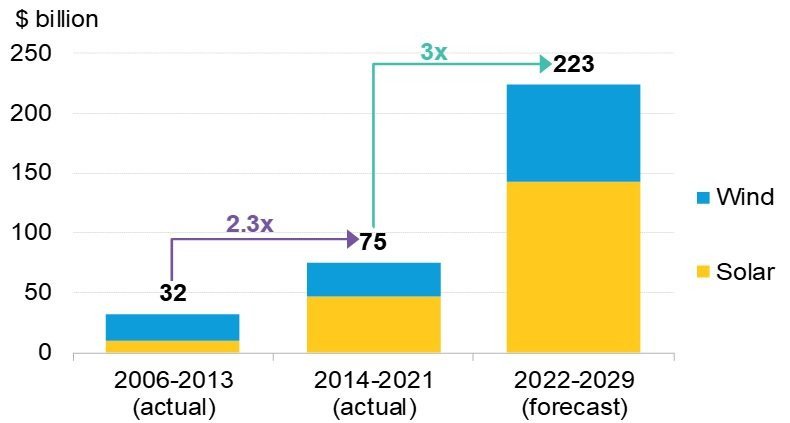India will require investments worth $223 billion to meet its 2030 wind, solar goals: BNEF
India will require $223 billion of investment to meet its goal of wind and solar capacity installations by 2030, according to a new report by research company BloombergNEF (BNEF).
The goal is part of the five decarbonization targets that had been announced by Indian Prime Minister Narendra Modi at COP26 in November 2021. Additionally, India aims to meet 50 percent of its electricity demand from renewable energy, thereby making renewable energy especially crucial in meeting the country's 2030 and 2070 climate goals.
The report "Financing India's 2030 Renewables Ambition", published in association with the Power Foundation of India, finds that corporate commitments from Indian companies could help India achieve 86 percent of its 2030 goals of building 500GW of cumulative non-fossil power generation capacity. By 2021 165GW of zero-carbon generation had already been installed in the country. India's Central Electricity Authority forecasts the country's reliance on coal to drop from 53 percent of installed capacity in 2021 to 33 percent in 2030, whereas solar and wind together make up 51 percent by then, up from 2 percent in 2021.
India has consistently ranked among the leading emerging markets covered by Climatescope, BNEF's flagship report analyzing market attractiveness for energy transition investment. In 2021, India ranked first in the power category among 107 emerging markets. Transparent market mechanisms, supportive policies, and ambitious government targets have attracted many domestic and international players to India's renewables market.
Shantanu Jaiswal, lead author of the report and head of India research at BloombergNEF, said: "To date, the growth of renewable energy in India has been funded by a diverse set of financiers. Debt and equity structures have evolved as the market grew and new risks emerged. India's ambitious renewable energy targets now require further scaling up of financing with new instruments and learnings from other global markets."
Yet, the scaling up of renewables in India faces regulatory, project, and financing risks, with PPA renegotiation, land acquisition, and payment delays cited as key risks by industry stakeholders surveyed by BloombergNEF. In the short-term, rising interest rates, a depreciating rupee, and high inflation create challenges for the financing of renewables.
Rohit Gadre, an analyst in BNEF's India research team, commented: "Scaling up financing to meet 2030 goals requires Independent Power Producers to tap into new or underutilized sources of capital. These could be revolving around construction debt, investment infrastructure trusts, and funding from retail investors, insurance companies, and pension funds. Higher funding requirements also need measures that can increase the availability of financing, such as de-risking renewable projects to offering contractual terms that provide greater comfort to investors."
The report examines the challenges of financing renewables, identifies new or underutilized sources of capital, and outlines measures to increase the availability of financing.



















